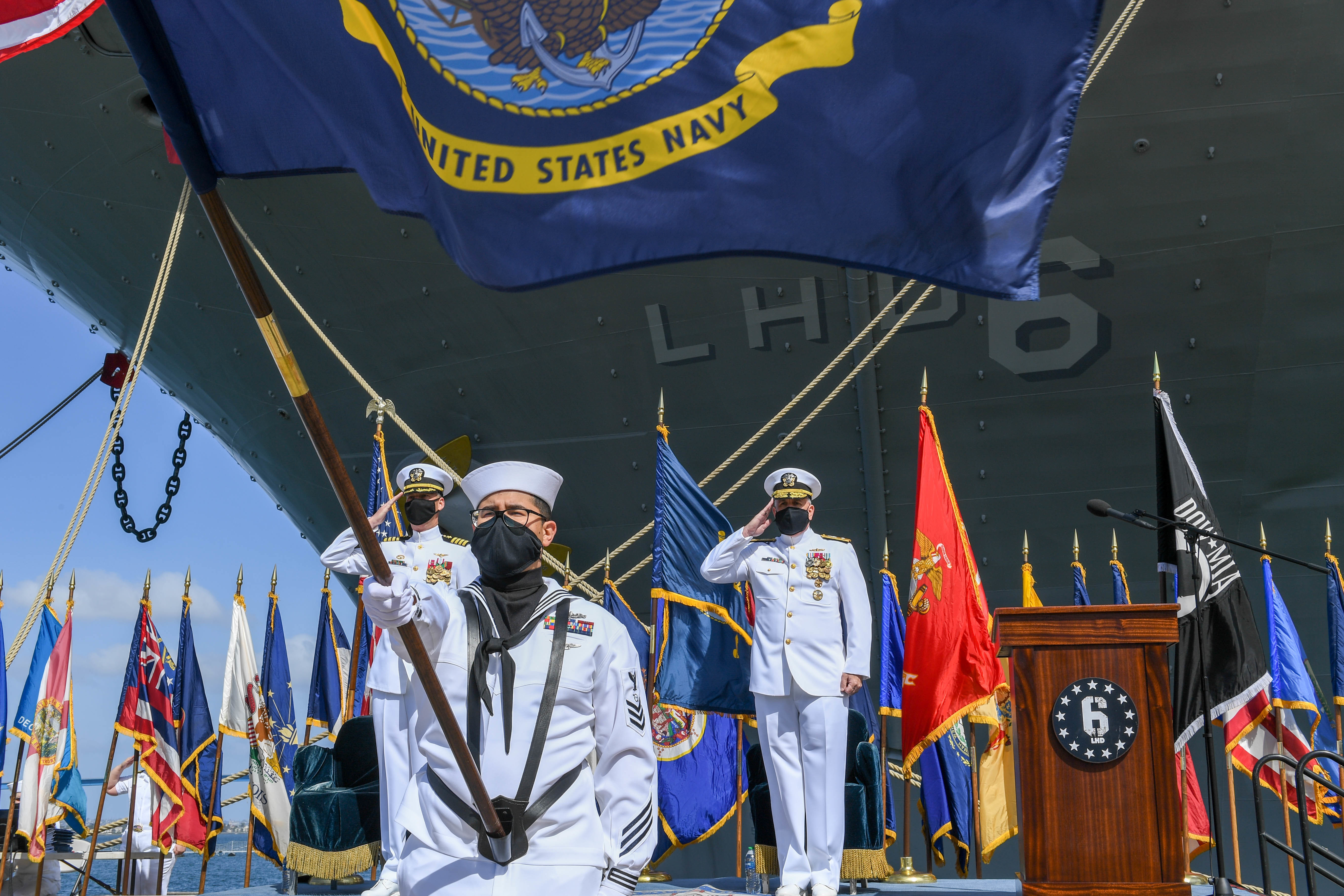
USS Bonhomme Richard (LHD-6) was decommissioned today, 22 years into a 40-year expected service life, following a fire last summer on the amphibious assault ship that damaged the island and flight deck beyond affordable repair.
The fire broke out during a pier-side maintenance availability, on a Sunday morning when few personnel were around to put out the fire in its earliest moments. The five-day firefighting effort ultimately involved personnel from nearly every single ship at Naval Base San Diego and from all nearby local and federal firefighting units. The great heat – as high as 1,200 degrees Fahrenheit – and the duration of the fire damaged the island, mast and flight deck, as well as most of the computer systems and sensors housed in those spaces.
The Navy decided in November to decommission the ship instead of spending between $2.5 billion and $3.2 billion over five to seven years to rebuild it as an amphibious ship or “in excess of a billion dollars” to rebuild it into a less capable configuration to serve a new mission.
The decommissioning took place today at Naval Base San Diego in a closed ceremony while sailors assigned to the ship watched from a closed-circuit feed at other parts of the naval base.
“As BHR sailors disperse throughout the fleet, take the teamwork, spirit, and unity to your next command,” Capt. Gregory Thoroman, Bonhomme Richard’s commanding officer, said in a speech at the ceremony. “For this crew and what we experienced together is the embodiment of our core values of honor, courage, and commitment. The resiliency I saw – man or woman, seaman and up to our highest ranks, united in our common cause and strength to depend on each other – lived up to my motto of train to fight and fight to win. It has been my honor and absolute privilege to serve as your commanding officer.”
Nine months after the fire, several key questions still remain unanswered.
First is how the fire broke out in the first place, as well as how it became so unmanageable so quickly. The Navy has seen many other fires during maintenance availabilities in recent decades, but a five-day duration is very unusual.
The Navy has acknowledged that the ship’s fire suppression systems were down due to the ship being in maintenance, and few personnel were around on a Sunday morning with little activity planned for that day. Still, a fire watch should have been in place with proper precautions given that the automatic fire suppression systems were offline.
The Navy has said little on this topic, as investigations are still ongoing. Four investigations are taking place in parallel: a Naval Criminal Investigative Service (NCIS) criminal investigation, which includes the Bureau of Alcohol, Tobacco, Firearms and Explosives (ATF); a command investigation led by Vice Adm. Scott Conn, the commander of U.S. 3rd Fleet; a Naval Sea Systems Command failure review board, which will look at safety, structural and design issues related to the ship and how changes could be made to prevent a fire from tearing through the hull the way it did on Bonhomme Richard; and a NAVSEA safety investigation board to examine the events that took place on the ship leading up to the fire compared to existing policies and procedures.
A second major question that remains unanswered is the fleet impact. The Navy saw reduced readiness rates from its amphibious warships throughout the 2010s, as maintenance work at private shipyards was plagued by backlogs and delays. Though the situation at the private yards has improved over the last year or two, the Navy now finds itself down a capital ship – raising questions as to whether the remaining nine Wasp-class and America-class amphibious assault ships will be asked to operate more to make up the difference, or if the Navy and Marine Corps will just see less availability for amphibious warfare training and operations.
The Navy cannot afford to buy a direct replacement, nor could Ingalls Shipbuilding squeeze another new ship into its production line. A multi-ship deal to buy LHA-9 and three LPDs could accelerate the delivery of LHA-9 by about a year, USNI News understands. USNI News also understands that LHA-8, the future Bougainville, was meant to be homeported on the East Coast but could instead go to the West Coast to help take the place of Bonhomme Richard, though the fleet as a whole would still be down a ship.
The Navy in February began a salvage effort, taking the island off the ship to make it easier for the ship hull to be towed to a scrapping yard for dismantling. This followed work last summer to remove the aft mast out of an abundance of caution, due to worries about structural integrity following the long exposure to very high heat. The forward mast collapsed during the fire.
The Navy said in November that decommissioning the ship – including the inactivation, harvesting parts to return to the fleet supply system, towing the ship from San Diego and scrapping the hull in a Gulf Coast yard – will cost about $30 million and take nine to 12 months.





